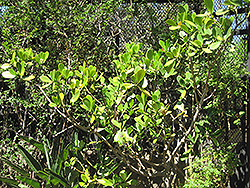It's all about ...
plants

Height: 25 feet
Spread: 20 feet
Sunlight:
![]()
![]()
Hardiness Zone: 10a
Other Names: Scotch Attorney, Florida Clusia
Description:
An adaptable tree with a densely foliated crown; thick green leaves with olive undersides; showy pink and white flowers primarily in summer; drought tolerant once established, but grows rapidly in moist soils; highly tolerant of seaside wind and spray
Ornamental Features
Autograph Tree features showy white round flowers with gold eyes and pink spots at the ends of the branches from late winter to late fall. It has attractive grayish green foliage with olive green undersides and tinges of chartreuse. The oval leaves are highly ornamental and remain grayish green throughout the winter. It produces light green capsules with creamy white blush from mid summer to late winter, which fade to black over time. The fruit can be messy if allowed to drop on the lawn or walkways, and may require occasional clean-up. The smooth gray bark adds an interesting dimension to the landscape.
Landscape Attributes
Autograph Tree is a multi-stemmed evergreen tree with an upright spreading habit of growth. Its average texture blends into the landscape, but can be balanced by one or two finer or coarser trees or shrubs for an effective composition.
This tree will require occasional maintenance and upkeep, and should only be pruned after flowering to avoid removing any of the current season's flowers. It is a good choice for attracting birds to your yard. It has no significant negative characteristics.
Autograph Tree is recommended for the following landscape applications;
- Accent
- Mass Planting
- Hedges/Screening
- Windbreaks and Shelterbelts
- Naturalizing And Woodland Gardens
Planting & Growing
Autograph Tree will grow to be about 25 feet tall at maturity, with a spread of 20 feet. It has a low canopy with a typical clearance of 3 feet from the ground, and should not be planted underneath power lines. It grows at a fast rate, and under ideal conditions can be expected to live for approximately 30 years.
This tree does best in full sun to partial shade. It is very adaptable to both dry and moist growing conditions, but will not tolerate any standing water. It is considered to be drought-tolerant, and thus makes an ideal choice for xeriscaping or the moisture-conserving landscape. This plant will benefit from an application of bonemeal and/or mycorrhizal fertilizer at the time of planting. It is not particular as to soil pH, but grows best in sandy soils, and is able to handle environmental salt. It is somewhat tolerant of urban pollution. This species is native to parts of North America, and parts of it are known to be toxic to humans and animals, so care should be exercised in planting it around children and pets.
This plant is not reliably hardy in our region, and certain restrictions may apply; contact the store for more information.


